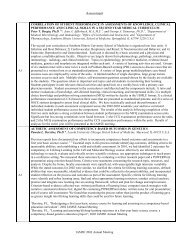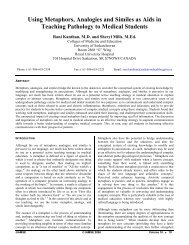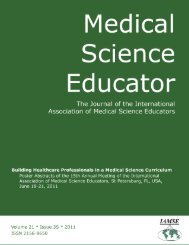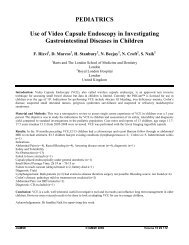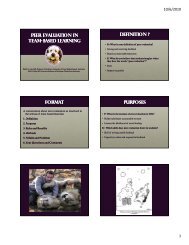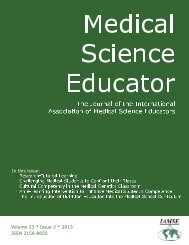Click here to view complete journal in pdf-format - IAMSE
Click here to view complete journal in pdf-format - IAMSE
Click here to view complete journal in pdf-format - IAMSE
You also want an ePaper? Increase the reach of your titles
YUMPU automatically turns print PDFs into web optimized ePapers that Google loves.
concept turned out <strong>to</strong> be effective. Third year<br />
students do remember very well what they felt <strong>to</strong> be<br />
difficult <strong>to</strong> understand <strong>in</strong> their first and second year<br />
basic science modules. As a result they feel very<br />
motivated and responsible <strong>to</strong> teach their younger<br />
peers. They also managed <strong>to</strong> expla<strong>in</strong> the cl<strong>in</strong>ical<br />
relevance of basic science concepts explicitly. Expert<br />
teachers often do this more implicitly based on<br />
pattern recognition skills. Develop<strong>in</strong>g the video<br />
presentation turned out <strong>to</strong> be time and cost<br />
efficient. The digital materials can be repeated by<br />
the students over and over, <strong>in</strong>dependent from time<br />
and place.<br />
CONCLUSIONS<br />
Present<strong>in</strong>g difficult basic science concepts <strong>in</strong><br />
relation <strong>to</strong> cl<strong>in</strong>ical syndromes by third year medical<br />
students turns out <strong>to</strong> be effective. This summer the<br />
recorded materials will be implemented as blended<br />
learn<strong>in</strong>g materials <strong>in</strong> the three cl<strong>in</strong>ical courses and<br />
will be made available <strong>to</strong> the students through the<br />
Blackboard Learn<strong>in</strong>g Environment. At the end of<br />
each course the presentations will be evaluated<br />
us<strong>in</strong>g a survey among the students.<br />
E-Learn<strong>in</strong>g Abstract ID: 176 eDemo<br />
STUDENT DOCTOR NETWORK: SOCIAL<br />
NETWORK SEMANTIC ANALYSIS<br />
Ryan Kirk and Amanda Fales-Williams, Iowa State<br />
University, Ames, Iowa, USA<br />
PURPOSE<br />
Websites such as Student Doc<strong>to</strong>r Network (SDN)<br />
provide professional and pre-professional students<br />
<strong>in</strong> medical fields an onl<strong>in</strong>e community for<br />
<strong>in</strong><strong>format</strong>ion exchange and support. Awareness of<br />
student discussions on medical-specific social media<br />
sites may help adm<strong>in</strong>istra<strong>to</strong>rs recognize themes<br />
relat<strong>in</strong>g <strong>to</strong> academic stress, external pressures, debt<br />
awareness, and self-imposed professional<br />
expectations of their peers.<br />
METHODS<br />
We accessed data from thousands of Pre-Veter<strong>in</strong>ary<br />
forum posts on SDN, represent<strong>in</strong>g roughly 1000<br />
users' comments dur<strong>in</strong>g 2011. We exam<strong>in</strong>ed how<br />
users were <strong>in</strong>terconnected via forum conversations<br />
us<strong>in</strong>g first-order logic <strong>to</strong> propagate connections. The<br />
data was parsed, cleaned and organized us<strong>in</strong>g<br />
natural language process<strong>in</strong>g techniques. Through<br />
facet<strong>in</strong>g the data and us<strong>in</strong>g probabilistic latent<br />
semantic analysis, we statistically exam<strong>in</strong>ed<br />
temporal and semantic patterns with<strong>in</strong> these data.<br />
F<strong>in</strong>ally, we used <strong>to</strong>ols from artificial <strong>in</strong>telligence <strong>to</strong><br />
graph the five statistically-derived most important<br />
concepts connect<strong>in</strong>g each user and forum <strong>in</strong><strong>to</strong> a<br />
s<strong>in</strong>gle network diagram.<br />
RESULTS<br />
The various data distillation techniques employed<br />
reduced the data from tens of thousands of data<br />
po<strong>in</strong>ts <strong>in</strong><strong>to</strong> a few hundred <strong>in</strong>terconnected ideas<br />
represent<strong>in</strong>g how socially constructed concepts are<br />
semantically and temporally <strong>in</strong>terconnected.<br />
CONCLUSIONS<br />
This technique allows a s<strong>in</strong>gle graph <strong>to</strong> display the<br />
type, importance, and number of connections, and<br />
the amount of data for each node. This allows<br />
subjective <strong>in</strong>terpretations of student discussions <strong>to</strong><br />
be visualized semi-quantitatively. For <strong>in</strong>stance, SDN<br />
Pre-Veter<strong>in</strong>ary conversations are overall focused on<br />
veter<strong>in</strong>ary school application (process-centered)<br />
rather than on specific veter<strong>in</strong>ary concepts (contentcentered).<br />
E-Learn<strong>in</strong>g Abstract ID: 177<br />
SOCIAL MEDIA AS A SUPPORT FOR<br />
REFLECTIVE PRACTICE AMONG FIRST-<br />
YEAR MEDICAL STUDENTS<br />
Mary T. Johnson, Ph.D. Des Mo<strong>in</strong>es University<br />
College of Osteopathic Medic<strong>in</strong>e; Maggie<br />
Blackburn, M.D., Terri Johnson, M.S., Debralee<br />
Laseur, B.M. Florida State University College of<br />
Medic<strong>in</strong>e, FL, USA<br />
PURPOSE<br />
This study exam<strong>in</strong>ed the use of the Yammer social<br />
network<strong>in</strong>g platform for first year medical students<br />
<strong>to</strong> share experiences, reflections and assignments <strong>in</strong><br />
a cl<strong>in</strong>ical and experiential learn<strong>in</strong>g course. Social<br />
network<strong>in</strong>g can enable persistent communication<br />
that enhances learn<strong>in</strong>g. We used qualitative<br />
research methods <strong>to</strong> analyze student messages for<br />
evidence that medical students construct mean<strong>in</strong>g<br />
through brief communications mediated by social<br />
network<strong>in</strong>g.<br />
METHODS<br />
120 first year medical students spent 3 weeks <strong>in</strong> an<br />
emersion experience with community-based<br />
primary care precep<strong>to</strong>rs, supplemented by a<br />
distance learn<strong>in</strong>g component. Precep<strong>to</strong>rs were<br />
spread across a wide geographical area. Students<br />
were asked <strong>to</strong> share their experiences us<strong>in</strong>g<br />
microblog reflections posted on Yammer.<br />
Reflections were evaluated by cod<strong>in</strong>g and thematic<br />
analysis us<strong>in</strong>g NVivo software.<br />
Medical Science Educa<strong>to</strong>r © <strong>IAMSE</strong> 2012 Volume 22(4S) 307



